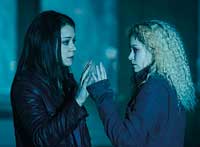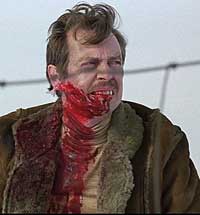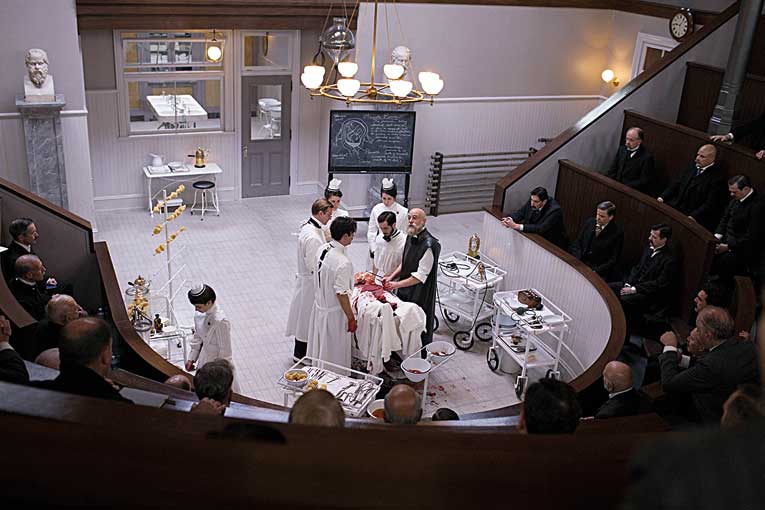
|
Author disclaimer: this article contains a considerable amount of spoilers
THE SERIES PHENOMENOn The twenty-first century brings an unprecedented narrative and visual phenomenon with millions of viewers all around the world: TV series. Of course, there were always series on TV, but The Wire (2002-2008) and The Sopranos (1999-2007) marked the start to what critical consensus has named the «Third Golden Age of Television». TV series in this new century are generally more complex than before, with more ambitious narratives and aesthetics, and have reached an extraordinary amount of people. The narrative universe of a TV series is not limited to television broadcasts, it is woven in websites, YouTube videos, Twitter accounts and other communication channels (official or otherwise). In addition, in our current globalised and connected world, TV series have armies of fans analysing them day by day, generating an enormous amount of information that the sharpest writers know how to use. Some people even write fan fiction, which, whether we like it or not, expands the universe of the series. This phenomenon has, therefore, transformed both the concept of the audiovisual narrative and the viewing and interpretation models. In view of all this, some experts already claim that, if the nineteenth century was the century of the novel and the twentieth century, of the cinema, then television series are the narrative form of the twenty-first century. THE NARRATIVE APPLICATIONS OF SCIENCe The influence of science is undeniable in other cultural manifestations; particularly, in literary and audiovisual narrative. Many writers have included scientific content to increase the authenticity of their stories and others have tied their stories around scientific knowledge, which plays the role of a treasure, a miracle cure or an endless energy source. Science fiction authors have always stretched the boundaries of science to speculate about a future where scientific and technological advances distort the social and moral order. But some authors went a bit further and used science not as an additional element in the story, but as a relevant part of the narrative and aesthetic structure of the work, as a fluid that permeates the deep structure of the narrative and makes it more nuanced. Some examples of this are the novels Brummstein and Machine by the Danish author Peter Adolphsen, Proyecto Nocilla by the writer from A Coruña Agustín Fernández Mallo, or even some sections of The Kreutzer Sonata by Tolstoy. We could say all these works use science as a narrative technique. It is used in many ways, but, differently from what happened in old series, science is now a narrative technique. Let us look at some examples. WHERE WILL TECHNOLOGY TAKE US? Black Mirror makes it clear that science fiction does not need spaceships, lightsabers or time-travel to awe the viewer. The series explores the darkest aspects of technology, those that solve old problems while creating new ones. |
«Science fiction authors have always stretched the boundaries of science to speculate about a future where scientific and technological advances distort the social and moral order»
|
|
 Zeppotron Black Mirror explores the darkest aspects of technology, those that solve old problems while creating new ones. |
«Experts claim that memory has changed since the emergence of Google, but how would our lives and brains be if we could relive detailed memories on demand?» |
|
| The third episode, for instance, considers a technology that would give us unlimited memory. Whoever so desires can have a video micro-camera in the eye that registers absolutely everything. Furthermore, it is easy to rewind, access the feed and project the video on a screen or wall. This situation has many practical consequences: firstly, the act of lying becomes more complicated because anyone can recover images at any moment to expose the lie. Therefore, it implies an authentic commitment to everything one does and says. Are we prepared? Are we aware of everything? Do we prefer to bury some things forever in an unrecoverable past?
In this context, memories would play a very different role. Experts claim that memory has changed since the emergence of Google, but what would our lives and brains become if we could relive detailed memories on demand? As Enrique Vila-Matas wrote at the beginning of the unforgettable Lejos de Veracruz, «nostalgia of a place is only enriching if it keeps being nostalgia, recovering it is death». Would it make sense, therefore, to relive happy memories? What if they are not so happy now? LOVE IN THE TIME OF QUANTUM MECHANICs According to the multiverse theory, there can be an unlimited number of parallel universes where every combination of events would happen. It may seem crazy, but some scientists claim that assuming the existence of parallel universes would help to explain the behaviour of matter at microscopic scales much better. This hypothesis has an extraordinary narrative potential and is the blueprint used in Fringe, a series that starts, as The X-Files, with a special police unit that solves mysterious cases. Fringe starts with a procedural, monster-of-the-week structure, but the underlying plot, based on the existence of a parallel universe that interacts with the universe of the main characters, emerges gradually. Apart from generating some dramatic tension, it inevitably raises the question of identity. Comparing the same character in both universes makes us reflect on who we are. Fringe also has an intertwined love story that becomes epic due to the existence of the parallel universe. If we were an especially cheesy critic, we could say that the theory of parallel universes brought us one of the great love stories of the twenty-first centuries. SCIENTIFIC COUCH HUMOUr Scientific jokes are the key of The Big Bang Theory’s success, a sitcom that follows the daily life of a group of young scientists, their professional career, love life, and their passion for comics, Star Wars and Star Trek. Most characters are exaggerated stereotypes, especially Sheldon, a brilliant ultra-rationalist who interprets the world literally and in incapable of understanding irony. The evolution of these characters and their relationship with the rest of the world create situations bordering the absurd, and produce a type of intelligent humour based on quite complex scientific concepts such as string theory or the superiority complex of some theoretical physicists compared to the rest of scientists. Another interesting aspect of the treatment of science in the series is the immediate inclusion of scientific news, such as the detection of the famous Higgs boson in 2012 or the announcement of the alleged detection of primordial gravitational waves in 2014. This additions act as a link between the characters and the daily world of the viewer, making their relationship more intimate. Because of its humour patina, its characters and situations, The Big Bang Theory has been compared to Friends, but although the characters evolve personally, the process is not intensive enough, as it was in Friends, to sustain the series interest. The Big Bang Theory survives essentially because of humour and the continuous delivery of one-liners. If the writers keep sharpening their tongues, we will keep laughing at Sheldon’s eccentricities for several seasons more. |
||
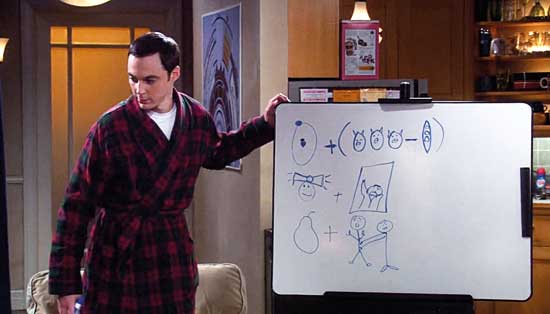 Warner Bros An important aspect of the use of science in The Big Bang Theory is the immediate inclusion of scientific news. In the picture, a scene where Sheldon Cooper tries to describe the Higgs boson in drawings. Warner Bros An important aspect of the use of science in The Big Bang Theory is the immediate inclusion of scientific news. In the picture, a scene where Sheldon Cooper tries to describe the Higgs boson in drawings. |
«The Big Bang Theory survives essentially because of humour and the continuous delivery of one-liners» | |
|
Richard Feynman, who was declared mentally handicapped by the army of the United States and won the Nobel Prize for Physics, was also one of the scientists who consciously worked on the construction of the atomic bombs dropped on Hiroshima and Nagasaki. Years later, after realising that many more bombs would be produced, he slipped into depression. He did not see the point in building anything, not even a bridge, if it would be destroyed sooner or later. Feynman’s ethical conflict, knowledge and how it is put to use, is one of the main topics in Manhattan, a series that, after visually and narratively terrific opening credits, recreates the moment when, together with Feynman, the most brilliant minds in the United States gathered in the New Mexico wasteland to build the atomic bomb before the Nazis did. Manhattan is full of Kafkaesque nuances: hundreds of isolated scientists in the middle of nowhere, subjected to military discipline and state secrets, working around the clock in partial and decontextualised calculations to avoid information leaks, under pressure, without the possibility to share anything with their families. In a scene, one of the scientists needs to let off some steam and confesses that he is building an atomic bomb to an indigenous person who does not understand his language. |
|
|
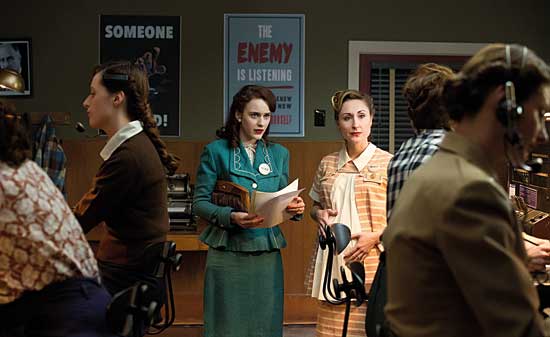 WGN America WGN AmericaManhattan recreates the moment when, together with Feynman, the most brilliant minds in the United States gathered to build the atomic bomb before the Nazis did. |
||
| Therefore, there is a lot of science in Manhattan, mixed with politics, a certain degree of paranoia, suspicion, espionage and counter-intelligence plots. Regarding its main characters, some portray real people such as Robert Oppenheimer or Niels Bohr, who get into heated scientific debates in front of blackboards covered in equations and continuously refer to works by other scientists.
The run towards the bomb, in addition is not only an issue confronting North-Americans and Nazis, but also pitting the scientists of the group against each other. Two research groups compete to achieve a functional bomb. The tensions generated by the competition are also one of the most powerful narrative points of the series, carrying the plot towards a final dramatic burst at the end of the first season. Who am I? Episodes titled with quotes from Darwin’s On the Origin of Species, the genetic code as a patent and cloning as a commercial production process. That is the scientific frame for Orphan Black, a fast-paced science fiction thriller with well-constructed characters. The series follows a woman who, by mere chance, begins to discover the existence of other women who are identical to her. When a group of genetically identical people first meet, the topic of identity raises naturally. What role do genes play in who and how we are? What part of ourselves depends on other circumstances? Who made us like this and why? If it was done for commercial purposes, what does that have to do with the ethics we were taught at school? All of these questions move the main characters of the series, who fight to answer them in the midst of conspiracies, chase sequences and threats. These characters, all played by the same actress, Tatiana Maslany, in a series of monumental performances, manage to convey the confusion we all have felt sometimes, when, looking at a clear and starry sky, we have wondered who we are. Doctor Thackery & Lady Cocaine After TV series such as Grey’s Anatomy or House, some seriesphiles suspected that medical drama was exhausted. The first five minutes of The Knick were enough for them to be astonished and to shock the genre to life again, as if using a defibrillator. The Knick is set in early twentieth-century New York, in the Knickerboxer hospital, a centre for the rich in a poor district. The initial duality introduces a series full of contrasts and double lives: the corrupt manager of the hospital, a nun who performes illegal abortions, a shy nurse who uses cocaine to boost sexual pleasure and the protagonist, Doctor Thackery, a brilliant, attractive, arrogant man with a serious addiction intravenous cocaine and to opium, who struggles to find a piece of skin without scabs. The Knick revolves around the pioneering research carried out in the hospital, always risky and in the edge of knowledge. In The Knick, risk is usually great, because failure involves the death of the patient. The pressure element works throughout the series as a very effective dramatic trigger. Doctors are required to carry out research, to discover and innovate. If they do not, people die, often in front of an audience, in operating theatres where surgeons present new techniques to their colleagues. In addition, The Knick has a very particular look: most scenes are candle-lit, stressing the light contrasts in the characters’ faces. Electronic music contrasts with the carriages, top hats and sideburns of the time. The aesthetic approach, including light and music, contributes to reinforce the idea of contrast in a series full of shadows: the double life of the characters, corruption in the hospital and, finally, hones medicine saving lives but also becoming a show for an audience. |
«When a group of genetically identical people first meet, the topic of identity raises naturally. What role do genes play in who we are?» BBC America Orphan Black follows a woman who, by mere chance, begins to discover the existence of other women who are identical to her. The genetic code as a patent and cloning as a commercial production process are some of the aspects used to frame the series scientifically. |
|
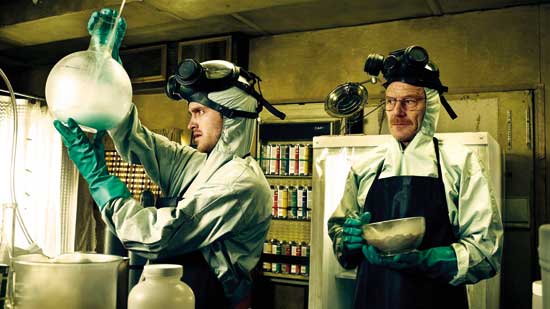 AMC Science is key in Breaking Bad. Walter White, the main character, uses chemistry not only to produce methamphetamine, but also to solve problems and develop a career as a drugs producer and trafficker. AMC Science is key in Breaking Bad. Walter White, the main character, uses chemistry not only to produce methamphetamine, but also to solve problems and develop a career as a drugs producer and trafficker. |
«But Breaking Bad goes beyond the Promethean use of science and uses it also create story lines that provide the ambition of perfect art to the series» | |
|
The chemistry of evil When Walter White, a chemistry teacher with a pregnant wife and a son who suffers from cerebral palsy, is diagnosed with a lung cancer, and their insurance does not cover the treatment. Walter White then decides to use his chemistry knowledge to synthesise methamphetamine and raise money to pay the treatment and the future of the family. This is the starting point of Breaking Bad. From the first moment, science is clearly essential for the series. Even the opening titles’ aesthetic is based on the periodic table. We soon discover that Walter White uses chemistry not only to produce methamphetamine, but also to solve problems and develop a career as a drugs producer and trafficker. But Breaking Bad goes beyond the Promethean use of science and uses it also create story lines that provide the ambition of perfect art to the series. In one of the first episodes, Walter White explains chirality to his students. It is a fundamental concept in chemistry, coming from the Greek word for hand: just as hands are mirrored images of each other, identical but opposed, some chemical compounds can exist in two different forms, molecular mirror images of each other; although they look identical, they do not behave the same way. Walter White concludes the speech repeating the words chiral, chirality, specular images, active, inactive, good and bad. And with this memorable scene, a harmless chemistry lesson, the series foreshadows the future dual nature of Walter White and his alter ego Heisenberg, the methamphetamine trafficker he will become, a cruel and cunning individual who soon forgets the initial objective of the treatment, consumed by the uncontrollable lust for power. To round up the matter, methamphetamine turns out to be a chiral molecule. Only one of the forms is effective as a drug. The other is used to treat common colds. Steve Buscemi, his cheek bloody and pierced by a bullet, shames an apathetic man who gobbles down cereals in front of a soap opera and will finally axe him before putting him into a wood chopper. Twenty years ago, scenes like that one turned Fargo into an immortal film. That is why, when the Coen brothers, Ethan and Joel, announced that they would produce a new TV series also called Fargo, the news were received with a certain degree of scepticism. After the first season, however, scepticism has faded in a sea of shock and thirst for more. Fargo’s plot unveils in a Minnesota town buried in snow, where the arrival of a mysterious man coincides with a crime wave investigated by the police. The opening titles foreshadow solitary characters who will suffer some kind of bloody tragedy in a hostile and freezing environment. One of the fundamental themes of the series is evil, breaking into a placid-looking, innocent community, triggering the dark side of the community, maybe dormant in the cold of winter. In the key episode of the first season, the mysterious newcomer, Lorne Malvo, is interrogated by the local police and slips away with lies. When he is about to leave the police station, an agent faces him and asks how he can lie so calmly. Malvo, accompanied by a musical crescendo, gets closer and mysteriously asks if he knows why the human eye can differentiate more shades of green than of any other colour. He adds that, when the agent finds out the answer to this question, he will find the answer he is looking for. Later, the still puzzled agent asks a colleague, the charming Molly Solverson, who quickly answers that the human eye can distinguish more shades of green because humans have lived for thousands of years surrounded by vegetation, where a key survival trait is the ability to distinguish predators hiding in the brush. Therefore, the trait would have been fixed by natural selection. The initial question is, thus, answered: somehow, lying is a self-defence mechanism and an adaptation to a cruel world, full of potential enemies. The interpretation can be a cliché, but aesthetically, it plays a deeper role in the story. Because many of the decorations in the series are painted with green shades: walls, radiators, doors, tables, chairs… Everything is green. Therefore, the world of Fargo is divided in an external, inhospitable environment, almost uninhabitable, and a number of interior refuges built by people whose ancestors also lived in a jungle full of predators, where they needed to differentiate shades of green. Evidently, in this context, not many external interference is needed to unleash brutality, no matter how mysterious and evil. for more: Toni Pou is a science writer and communicator. He wrote the book Donde el día duerme con los ojos abiertos (Anagrama, 2013) and received the Godó Award to Investigation Journalism and the Prisma Award to Best science communication book. He collaborates with publications such as Ara, El Temps and Avui. He is also the curator of the itinerant exhibition «The Arctic is Breaking», created by “La Caixa” Foundation. © Mètode, 2015. |
«Fargo is divided in an external, inhospitable environment, almost uninhabitable, and a number of interior refuges built by people whose ancestors also lived in a jungle full of predators»
Polygram Filmed Entertainment Twenty years ago, scenes like the one in the still turned Fargo into a classic. That is why, when the Coen brothers, Ethan and Joel, announced that they would produce a new TV series under the same name, the news were received with a certain degree of scepticism.
|
|

